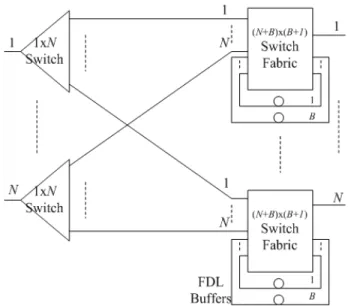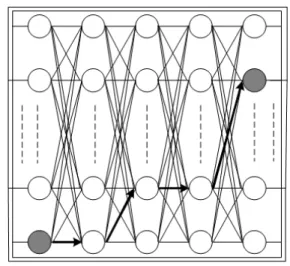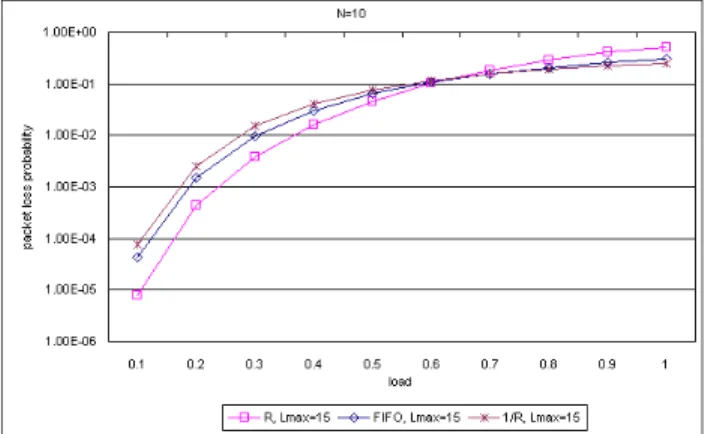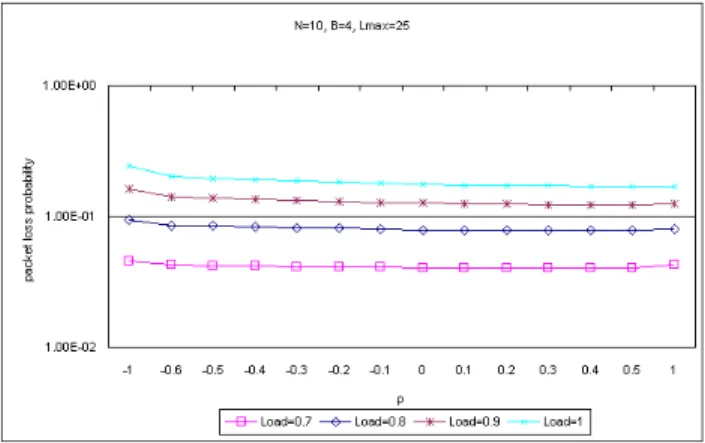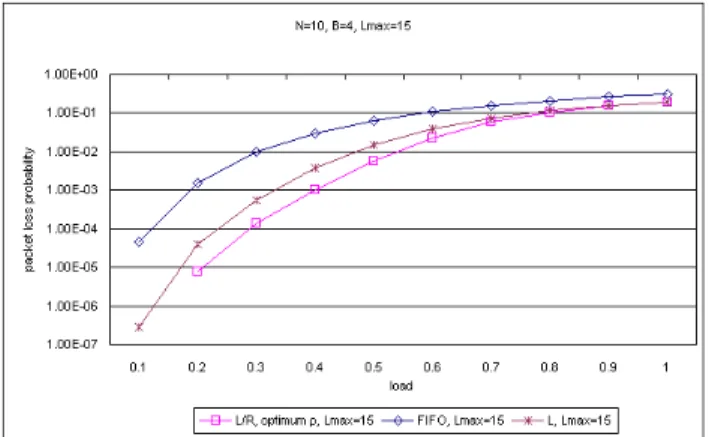Performance Analysis of a Packet Prioritization
Algorithm for Optical Packet Switching Networks
Guan-Hong Jhou
Department of Computer Science, National Chung-Hsing University, Taiwan.
Email: phd9604@cs.nchu.edu.tw
Woei Lin
Department of Computer Science, National Chung-Hsing University, Taiwan.
Email: wlin@cs.nchu.edu.tw
Abstract—Because of the explosive growth of network traffic, backbone networks move toward all-optical packet switching networks. However, optical buffers implemented by fiber delay line (FDL) have a volatile nature because of signal loss and noise accumulation problems from optical components of the FDL buffer. Because of this, scheduling packets becomes more difficult in the FDL buffer than in the RAM buffer, and requires additional design considerations for avoiding packet contention and packet loss from the volatile nature. Therefore, we propose a packet prioritization algorithm for all-optical packet switching networks with FDL buffers. The point of the packet prioritization algorithm is to rank packets in optimal balance between latency and residual distance. We optimize a relative-distance factor to achieve the lowest packet loss probability. Our simulation results show how various network parameters affect the optimal relative-latency factor.
Index Terms—Multi-hop packet scheduling, buffer man-agement, optical packet switching, fiber delay line buffer.
I. INTRODUCTION
Recently, the explosive growth of network ser-vices and multimedia applications has led to increas-ing demand on high-speed data transmission. Dense wavelength division multiplexing (DWDM) tech-nologies [1] offer an aggregate bandwidth for high-capacity optical networks, and all-optical packet switching based on DWDM technologies is a promising scheme to meet this demand and avoid electronic bottlenecks. However, all-optical packet switching suffers an output contention problem, because packets may arrive in an uncoordinated fashion.
In the optical domain, optical buffering imple-mented by fiber delay lines (FDLs) [2]–[6] is a
main solution to the output contention problem. Optical packets can be recirculated in FDLs to avoid the output contention. A lot of literature has been presented for construction and analysis of optical switches with FDL buffers. Some output buffer switches with FDL buffers were presented in [7]– [9]. Some shared buffer switches with FDL buffers were presented in [10]–[13], and some hybrid buffer switches with FDL buffers were presented in [14], [15].
However, optical buffering implemented by FDLs has a volatile nature, because of signal loss and noise accumulation problems from optical com-ponents of the FDL buffer. As [16]–[18] pointed out, crosstalk from optical links, optical switches, FDLs and Erbium-doped fiber amplifiers (EDFAs) induce signal loss and noise accumulation problems. Especially, the EDFA boosts signal power, but it produces amplified spontaneous emission (ASE) by the process of stimulated emission in a gain medium. Optical packets can not be excessively re-circulated in FDL buffers, so optical packets have a limited number of recirculation (loops) [2], [4], [6], [19] and a limited latency. Optical packets will be dropped, if the signal loss and noise accumulation problems induce that they can not be identified. Therefore, scheduling packets requires additional design considerations for these problems.
Much research has been presented for these prob-lems in a single optical switch or multiplexer with a limited number of recirculation, such as [6], [19], [20], but research in an optical packet switching network with a limited latency is short. However, it is impractical to expect that all optical packets have the same status and signal power when they
arrive each optical switch node. Furthermore, using optical packet regenerators with the O-E-O (Optical-Electrical-Optical) conversion to solve signal loss and noise accumulation problems needs to pay huge expenses, latency especially. Therefore, research in how to reduce packet loss in optical networks with a limited latency is very important.
In this paper, we have focused our efforts on effective multi-hop packet scheduling algorithms [21], [22] to reduce the packet loss probability of all-optical packet switching networks with a limited latency. The latency and the residual distance of a packet are two key quantities of packet loss in all-optical packet switching networks with a limited latency, so we propose a packet prioritization al-gorithm based on these two quantities. The point of the packet prioritization algorithm is to rank packets in optimal balance between latency and residual distance. We optimize a relative-distance factor to achieve the lowest packet loss probability. Our simulation results show how various network parameters affect the optimal relative-latency factor. The rest of this paper is organized as follows. In Section II, we introduce our packet prioritiza-tion algorithm and network configuraprioritiza-tion in details. In Section III, we discuss effects of latency and residual distance on performance, and rank packets in optimal balance between latency and residual distance for achieving the lowest packet loss proba-bility. Finally, we conclude our discussion in Section IV.
II. A PACKETPRIORITIZATIONALGORITHM
A. Priority Function Π
The packet prioritization algorithm is based on a priority function for handling packets. The priority function, Π, comprises two parameters: L is the latency in hops for a packet to traverse and R is the residual distance in hops from the current locations to the destination, and
Π(R, L) = L
Rρ (1)
L and R, in fact, are the two key quantities for scheduling packets using the latency-aware disci-pline. Each packet is associated with a priority value given by Π(R, L) and updated hop by hop in the following manner. In the beginning, L and R are
initialized with an estimated latency and residual distance in hops for the packet, respectively. At each hop, L will be incremented by one and R will remain unchanged if it experiences an FDL recirculation, but R will be decremented by one if it departs. Moreover, a queued packet will be dropped if the sum of the residual distance and the latency is greater than the maximum latency, Lmax, because
it will never arrive the destined node.
In the above formulation, ρ, referred to as relative-distance factor, controls the relative impor-tance of the two parameters. R outweighs L if ρ is greater than one, while L outweighs R if ρ is smaller than one. In this fashion, we can also use the priority function to differentiate packets of real-time applications from best-effect ones. For example, packets of strict timing requirement are initialized with higher values of L and they will be assigned a higher rank accordingly for the subsequent routing. B. Major Elements of the Packet Prioritization Al-gorithm
We are concerned with a packet prioritization al-gorithm with the following functional requirements: 1) Rank packets in optimal balance between the
latency and the residual distance;
2) Maintain a queue on the FDL buffer that con-forms to the results calculated by the priority function; and
3) Schedule packets to depart the output port ac-cording to the ranking and without contention. It is worth mentioning that scheduling packets in the FDL buffer is fairly different from its electronic counterpart in the RAM buffer. This is due to the fact that the FDL buffer can hold a packet only for a small period of time given by the designated delay line. The stored packet must be moved to the specified switch output right before the delay time elapses. Otherwise, the deferred packet will be dropped for good. In a sense, the FDL buffer has a volatile nature that a packet exists in the buffer for the specified time period, because signal loss and noise accumulation problems from optical components of the FDL buffer. Because of this, scheduling packets becomes more difficult in the FDL buffer than in the RAM buffer. And it requires additional design considerations for avoiding
con-Fig. 1. An optical switch architecture for our study
tention among packets destined for the same output and at the same time.
C. Our Network Configuration
Our network configuration uses an optical net-work, which construct from slotted optical packet switches or photonic packet switches with FDL buffers. Fig. 1 shows an optical switch architecture for our study on scheduling packets. The output-buffered N x N switch is composed of N bufferless switches of size 1 x N and N output switches of size (N+B) x (N+1). The bufferless switches and the output switches are interconnected in a fully meshed manner, and the bufferless switches make the lookup faster by photonic label lookup function [23] for the head of arriving packets. The output switch comprises a set of FDLs and a switching fabric as well as feedback connections. This is the place where packets are buffered and scheduled for departing the switch. Assuming B FDLs of equal length, the switching fabric is of size (N+B) x (N+1). It is suitable to be modularized.
III. PERFORMANCEANALYSIS
In this section, we discuss effects of latency and residual distance on the performance of packet loss probability and average latency, and rank packets in optimal balance between latency and residual dis-tance to achieve the lowest packet loss probability. First, we intend to investigate effects of residual
Fig. 2. A mesh network for our simulation
distance and latency on the performance based on our simulation results. We use four extreme priority functions composed of latency or residual distance to investigate their respective effects. Second, we optimize the relative-distance factor ρ to achieve the lowest packet loss probability.
A. Simulation Model
We use a border-less mesh network to simulate an optical packet switching network. In this model, a hundred of optical packet switches are placed on a mesh network, as shown in Fig. 2, where each internal node directly connects to its four neighbours and peripheral nodes are connected through wrap-around links. For simplifying routing, we forms the mesh network to a border-less network, and routing optical packets follows bottom-up and left-right rules in the mesh network. However, an op-tical packet switch of the mesh network has only two input/output ports, because it connects with its only four neighbours. Therefore, we use a multi-wavelength concept to simulate a great number of input/output ports in the mesh network. For example, we use five wavelengths on each port to simulate ten input/output ports. We use this way to simulate the effect of a great number of input/output ports.
For packet generation, each packet is assigned a random routing path, initial latency and initial residual distance between one and the maximum residual distance Rmax. The initial latency is equal
to zero, and a queued packet will be dropped if the sum of the residual distance and the latency
is greater than the maximum latency Lmax. This
is because it will never reach the destined node. Furthermore, we assume that the packet generation is independent at each node with a generation rate λs per queue. Since each node gets arriving packets
from its neighbour nodes and itself, we further assume that the queue length distribution approx-imately forms a Poisson stream with an effective arrival rate λef f. Theoretically, the overall arrival
rate per queue is
λ = λs+ λs(E[R0] − 1), (2)
where E[R0] is the expected value of the initial
residual distance of an arriving packet in hops. λs(E[R0] − 1) is the arrival rate of packets from
neighbour nodes. Since packet is assigned a random routing path and an initial residual distance between one and Rmax, E[R0] is equal to (Rmax+ 1)/2.
However, since a queued packet will be dropped if the sum of the residual distance and the latency is greater than the maximum latency, we need to consider the effect of packet loss on the effective arrival rate λef f. Therefore, we rewrite (2), and have
λef f = λs+λs(E[R0]−1)(1−Ploss
E[Rloss]
E[R0] − 1
), (3) where Ploss is the packet loss probability and
E[Rloss] is the expected value of the residual
dis-tance of a dropped packet. The effective arrival rate of packets from neighbour nodes becomes λs(E[R0] − 1)(1 − Ploss
E[Rloss] − 1
E[R0] − 1
). The effective arrival rate of packets from a node itself is still λs.
In addition to the border-less mesh network, we also study our scheme on a multi-stage network as shown in Fig. 3,where each stage is composed of N nodes and each node has direct connections with all nodes of the previous stage and the next stage. In this multi-stage network, optical packets are routed randomly following left-to-right or right-to-left, and they are not exchanged between the nodes of the same stage. We have consistent results on the multi-stage network and the border-less mesh network when the network traffic is stable and the port number of both is the same number. For brevity, we abridge the discussion on the multi-stage network.
Fig. 3. A multi-stage network
Fig. 4. Packet loss probabilities of simulation results with different relative-latency priority functions
B. Effects of Latency and Residual Distance on the Performance
In this subsection, we discuss effects of latency and residual distance on the performance of packet loss probability and average latency in detail. The latency and the residual distance of a packet are two important parameters of packet loss for scheduling packets, so our priority function comprises these two parameters. For ranking packets in optimal balance between latency and residual distance, we need to understand respective effects of latency and residual distance on the performance. We use four extreme priority functions to find out their respective effects. The four extreme priority functions are L, 1/L, R and 1/R.
First, we discuss the effect of latency in all-optical packet switching networks with infinite FDL
Fig. 5. Latencies of simulation results with different relative-latency priority functions
Fig. 6. Packet loss probabilities of simulation results with different relative-distance priority functions
buffers. Fig. 4 and Fig. 5 illustrate packet loss probabilities and average latencies of simulation results with different relative-latency priority func-tions, L and 1/L. The traffic load follows the overall arrival rate per queue λ through (2), and the port number equals ten. Fig. 4 shows that the priority function L outperforms the priority function 1/L in terms of packet loss probability. This is because a queued packet with a long latency is easier to be transmitted than one with a short latency under the priority function L, and a queued packet will be dropped if the sum of the residual distance and the latency is greater than the maximum latency. Although the priority function L reduces the packet loss probability, Fig. 5 also shows it increases the average latency.
Second, we discuss the effect of residual distance in all-optical packet switching networks with infinite
Fig. 7. Latencies of simulation results with different relative-distance priority functions
FDL buffers. Fig. 6 and Fig. 7 illustrate packet loss probabilities and latencies of simulation results with different relative-distance priority function, R and 1/R. Fig. 6 shows that the priority function R outperforms the priority function 1/R in terms of packet loss probability but under high traffic load. Under low traffic load, the priority function R has the same effect like the priority function L, because a new packet with a long initial residual distance usually have a long latency when it has reached the destined node. However, it is just the opposite under high traffic load, because the network is over-crowded and a queued packet with a short residual distance is difficult to be transmitted even if it has a longer latency. This causes an adverse effect on packet loss probability under high traffic load.
On the other hand, the priority function 1/R outperforms the priority function R in terms of packet loss probability and average latency both under high traffic load. This is an interesting result, because increasing the average latency is usually a tradeoff for reducing the packet loss probability. The priority function 1/R can reduce the average latency, because a queued packet with a short resid-ual distance is easier to be transmitted than one with a long residual distance. A new packet with a long initial residual distance usually has a long latency when it has reached the destined node, and it is easier to be dropped than one with a short initial residual distance under the priority function 1/R. Therefore, most packets reached the destined node have a short residual distance and a short latency under the priority function 1/R. This achieves a
Fig. 8. Packet loss probabilities of simulation results with different relative-distance priority functions
Fig. 9. Latencies of simulation results with different relative-distance priority functions
small average latency and a big Rloss. Based on (3),
a big Rloss can reduce effective traffic load.
Furthermore, Fig. 8 and Fig. 9 illustrate packet loss probabilities and average latencies of simula-tion results of the relative-latency priority funcsimula-tions in all-optical packet switching networks with finite FDL buffers. The buffer size is equal to four. The results of all-optical packet switching networks with finite FDL buffers are close to the ones of all-optical packet switching networks with infinite FDL buffers, but the results of the priority function 1/R in all-optical packet switching networks with infinite FDL buffers have a better improvement rate than the ones in all-optical packet switching networks with infinite FDL buffers. This is because the priority function 1/R can reduce the effective traffic load and also reduce the packet loss probability from buffer overflow. This is an important thing for an
optical packet switching network with finite FDL buffers. Especially, Internet has a busty nature, and the busty nature induces a lot of packet loss from buffer overflow. The priority function 1/R can ef-fectively reduce effective the traffic load and reduce the packet loss probability from buffer overflow.
In addition, Fig. 6 and Fig. 8 also show that the packet loss probability from buffer overflow is much lower than the one from signal loss and noise accumulation problems. Comparing the results of 1/R in all-optical packet switching networks with infinite FDL buffers to the results of 1/R in all-optical packet switching networks with finite FDL buffers, the packet loss probability from buffer overflow is lower than four percent of the packet loss probability from signal loss and noise accumu-lation problems; even the buffer size is only four. This is because the maximum latency is usually smaller than the overall maximum latency that is equal to the buffer size multiplied by Rmax. A
huge number of packets will be dropped because of buffer overflow if the average latency is close to the overall maximum latency, but a huge number of packets will be dropped because of signal loss and noise accumulation problems before that. Therefore, the packet loss probability from buffer overflow is much lower than the one from signal loss and noise accumulation problems.
C. Optimal Values for the Relative-Distance Factor Based on the results of the previous subsection, we have known two important findings for the opti-mal balance between latency and residual distance. First, the priority functions L and R can reduce the packet loss probability but increase the average latency under low traffic load. Second, the priority functions L and 1/R can reduce the packet loss probability under high traffic load. Especially, the priority function 1/R can also reduce the average latency under high traffic load. Therefore, under low traffic load a priority function combined the priority functions L and R should reduce the packet loss probability more effectively, and under high traffic load a priority function combined the priority functions L and 1/R should reduce the packet loss probability more effectively.
We use various relative-distance factors in our priority function (1) to find out optimal balance
Fig. 10. Packet loss probabilities of simulation results under low traffic load and Lmax=15
Fig. 11. Packet loss probabilities of simulation results under high traffic load and Lmax=15
between latency and residual distance. Based on the two important findings, we should use a neg-ative relneg-ative-distance factor to combine the priority functions L and R under low traffic load, and use a positive relative-distance factor to combine the priority functions L and 1/R under high traffic load. Fig. 10, Fig. 11 and Fig. 12 illustrate packet loss probabilities of simulation results of our priority function with various relative-distance factors in all-optical packet switching networks with finite FDL buffers, B = 4. These results help us to find out op-timal balance between latency and residual distance to achieve the lowest packet loss probability.
Fig. 10 illustrates packet loss probabilities of simulation results of our priority function under low traffic load and Lmax=15. It shows that the optimal
relative-distance factor is between -0.4 and -0.5 under low traffic load in Fig. 10. When traffic load is equal to 0.2, the optimal relative-distance factor
Fig. 12. Packet loss probabilities of simulation results under high traffic load and Lmax=25
is equal to -0.5. When traffic load is equal to 0.4, the optimal relative-distance factor is equal to -0.4. Therefore, we know that using a negative relative-distance factor to combine the priority functions L and R is truly effective under low traffic load.
Fig. 11 illustrates packet loss probabilities of simulation results of our priority function under high traffic load and Lmax=15. It shows that the optimal
relative-distance factor is between -0.1 and -0.3 under high traffic load in Fig. 11. When traffic load is equal to 0.7, the optimal relative-distance factor is equal to -0.3. When traffic load is equal to 0.8 and 0.9, the optimal relative-distance factor is equal to -0.2. When traffic load is equal to 1.0, the optimal relative-distance factor is equal to -0.1. Obviously, the optimal relative-distance factor becomes more close to a positive number with traffic load growing. Furthermore, Fig. 12 illustrates packet loss proba-bilities of simulation results of our priority function under high traffic load and a greater maximum latency Lmax=25. It shows that the optimal
relative-distance factor is between 0.2 and 0.5 under high traffic load in Fig. 12. When traffic load is equal to 0.7 and 0.8, the optimal relative-distance factor is equal to 0.2. When traffic load is equal to 0.9 and 1.0, the optimal relative-distance factor is equal to 0.5. Comparing Fig. 12 with Fig. 11, we know that the optimal relative-distance factor under a great maximum latency becomes greater than the one under a small maximum latency. This is because a greater maximum latency can reduce the packet loss probability from the limited latency but from buffer overflow, and our priority function with a
Fig. 13. Packet loss probabilities of simulation results of different priority functions under Lmax=15
positive factor reduces the packet loss probability from buffer overflow like the priority functions 1/R. Consequently, we can optimize the relative-distance factor of our scheduling algorithm to achieve the lowest packet loss probability based on three observations:
1) The optimal relative-distance factor is a neg-ative number under low traffic load;
2) The optimal relative-distance factor becomes greater with traffic load growing;
3) The optimal relative-distance factor under a great maximum latency is greater than the one under a small maximum latency.
We can dynamically adapt the value of the relative-distance factor based on the three observations to achieve the lowest packet loss probability. Fig. 13 shows that our scheduling algorithm outperforms the FIFO approach and the priority function L in terms of packet loss probability. Especially, our scheduling algorithm is very effective for reducing the packet loss probability under low traffic load.
IV. CONCLUSION
We have proposed a packet prioritization algo-rithm for all-optical packet switching networks with FDL buffers. The point of the packet prioritization algorithm is to rank packets in optimal balance between latency and residual distance to achieve the lowest packet loss probability. Our simulation results show how various network parameters af-fect the optimal relative-latency factor. The optimal relative-distance factor is a negative number under low traffic load, and becomes greater with traffic
load growing. Furthermore, the optimal relative-distance factor under a great maximum latency is greater than the one under a small maximum la-tency. Based on these, we can optimize the relative-distance factor to achieve the lowest packet loss probability. Our simulation results show that the packet prioritization algorithm is very effective.
REFERENCES
[1] R. Ramaswami, K. Sivarajan, and S. O. service, Optical Net-works: A Practical Perspective. OSA, 2002.
[2] D. K. Hunter, M. C. Chia, and I. Andonovic, “Buffering in optical packet switches,” vol. 16, no. 12, pp. 2081–2094, Dec. 1998.
[3] L. Xu, H. G. Perros, and G. Rouskas, “Techniques for optical packet switching and optical burst switching,” vol. 39, no. 1, pp. 136–142, Jan. 2001.
[4] A. Als, Z. Ghassemlooy, G. Swift, P. Ball, and J. Chi, “Perfor-mance of the passive recirculating fiber loop buffer within an otdm transmission link,” Optics Communications, vol. 209, no. 1-3, pp. 137–147, 2002.
[5] W. Vanderbauwhede and D. Harle, “Architecture, design, and modeling of the opsnet asynchronous optical packet switching node,” Journal of Lightwave Technology, vol. 23, no. 7, p. 2215, 2005.
[6] W. Vanderbauwhede and H. Novella, “A multiexit recirculating optical packet buffer,” IEEE Photonics Technology Letters, vol. 17, no. 8, pp. 1749–1751, 2005.
[7] D. K. Hunter, W. D. Cornwell, T. H. Gilfedder, A. Franzen, and I. Andonovic, “Slob: a switch with large optical buffers for packet switching,” vol. 16, no. 10, pp. 1725–1736, Oct. 1998. [8] I. Chlamtac, A. Fumagalli, and C.-J. Suh, “Multibuffer delay
line architectures for efficient contention resolution in optical switching nodes,” vol. 48, no. 12, pp. 2089–2098, Dec. 2000. [9] H. Harai and M. Murata, “High-speed buffer management for
40 gb/s-based photonic packet switches,” vol. 14, no. 1, pp. 191–204, Feb. 2006.
[10] ——, “Optical fiber-delay-line buffer management in output-buffered photonic packet switch to support service differentia-tion,” vol. 24, no. 8, pp. 108–116, Part Supplement,&ug 2006. [11] K. Yiannopoulos, K. G. Vlachos, and E. Varvarigos, “Multiple-input-buffer and shared-buffer architectures for optical packet-and burst-switching networks,” vol. 25, no. 6, pp. 1379–1389, Jun. 2007.
[12] A. Lazzez, Y. Khlifi, S. Guemara El Fatmi, N. Boudriga, and M. Obaidat, “A novel node architecture for optical networks: Modeling, analysis and performance evaluation,” Computer Communications, vol. 30, no. 5, pp. 999–1014, 2007. [13] Y. Li, G. Xiao, and H. Ghafouri-Shiraz, “On the
perfor-mance of different node configurations in multi-fiber optical packet-switched networks,” Photonic Network Communica-tions, vol. 14, no. 1, pp. 11–22, 2007.
[14] J. Diao and P. L. Chu, “Analysis of partially shared buffering for wdm optical packet switching,” vol. 17, no. 12, pp. 2461–2469, Dec. 1999.
[15] S. Debnath, S. Mahapatra, and R. Gangopadhyay, “Analysis of an optical packet switch with partially shared buffer and wavelength conversion,” IET Communications, vol. 1, no. 4, pp. 810–818, August 2007.
[16] C. Larsen and M. Gustavsson, “Linear crosstalk in 44 semi-conductor optical amplifier gate switch matrix,” Lightwave Technology, Journal of, vol. 15, no. 10, pp. 1865–1870, Oct 1997.
[17] R. Geldenhuys, N. Chi, I. T. Monroy, A. M. J. Koonen, H. J. S. Dorren, F. W. Leuschner, G. D. Khoe, S. Yu, and Z. Wang, “Multiple recirculations through crosspoint switch fabric for recirculating optical buffering,” Electronics Letters, vol. 41, no. 20, pp. 1136–1138, Sep. 29, 2005.
[18] E. F. Burmeister and J. E. Bowers, “Integrated gate matrix switch for optical packet buffering,” vol. 18, no. 1, pp. 103– 105, Jan. 2006.
[19] J. Cheng, “Constructions of optical 2-to-1 fifo multiplexers with a limited number of recirculations,” vol. 54, no. 9, pp. 4040– 4052, Sep. 2008.
[20] J. Cheng, C.-S. Chang, T.-H. Chao, D.-S. Lee, and C.-M. Lien, “On constructions of optical queues with a limited number of recirculations,” in Proc. INFOCOM 2008. The 27th Conference on Computer Communications. IEEE, Apr. 13–18, 2008, pp. 664–672.
[21] V. Alaria, A. Bianco, P. Giaccone, E. Leonardi, F. Neri, and C. Syst, “Multi-hop scheduling algorithms in switches with reconfiguration latency,” p. 6, 2006.
[22] B. Liang and M. Dong, “Packet prioritization in multihop la-tency aware scheduling for delay constrained communication,” vol. 25, no. 4, pp. 819–830, May 2007.
[23] K. I. Kitayama and N. Wada, “Photonic ip routing,” vol. 11, no. 12, pp. 1689–1691, Dec. 1999.
